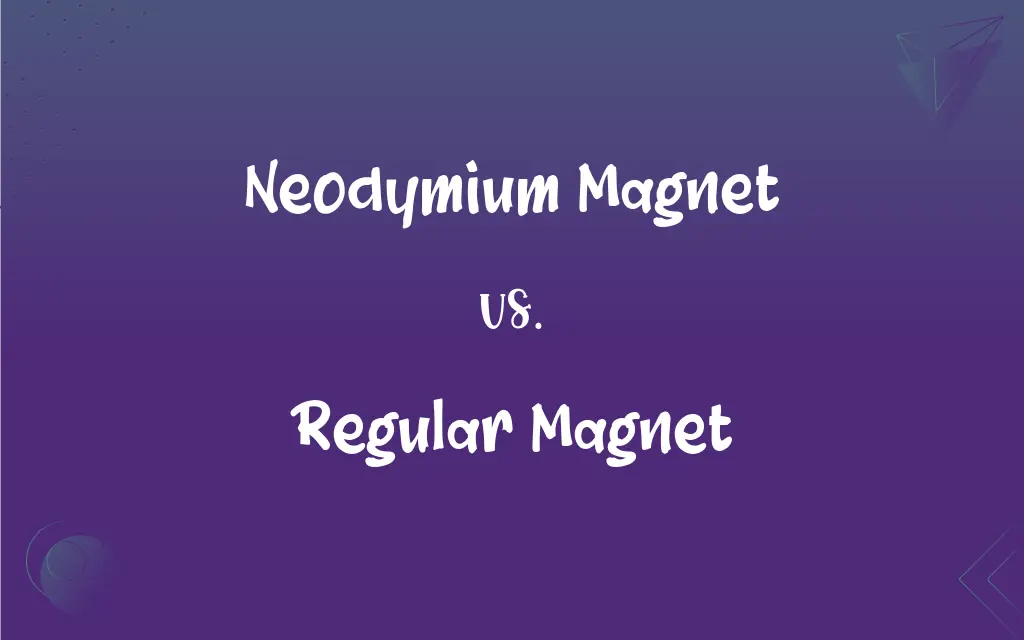Neodymium Magnet vs. Regular Magnet: What's the Difference?
Edited by Aimie Carlson || By Janet White || Published on December 12, 2023
Neodymium magnets are powerful, rare-earth magnets made from an alloy of neodymium, iron, and boron, whereas regular magnets are less potent, typically made from iron, nickel, or cobalt.

Key Differences
Neodymium magnets, composed of neodymium, iron, and boron, are known for their exceptional magnetic strength and are widely used in high-performance applications. While, regular magnets, typically made of materials like ferrite or alnico (aluminum, nickel, cobalt), are less powerful and more commonly found in everyday items.
The magnetic field of neodymium magnets is much stronger than that of regular magnets, making them ideal for applications where space is limited but strong magnetic force is required. In contrast, regular magnets, though weaker, are sufficient for simple applications like refrigerator magnets or educational tools.
In terms of durability, neodymium magnets are more prone to corrosion and require protective coatings, whereas regular magnets, especially ceramic ones, are more resistant to corrosion and can be used without such coatings.
Neodymium magnets have a higher coercivity, meaning they can maintain their magnetic properties at higher temperatures compared to regular magnets. However, regular magnets are more tolerant of extreme temperatures and environments, though they have a lower magnetic strength.
Cost-wise, neodymium magnets are more expensive due to their rare-earth composition and manufacturing process. Regular magnets, being made from more abundant materials, are generally cheaper and more accessible for everyday uses.
ADVERTISEMENT
Comparison Chart
Composition
Neodymium, iron, boron alloy
Iron, nickel, cobalt, or ferrite
Magnetic Strength
Very high
Moderate to low
Cost
More expensive
Less expensive
Corrosion Resistance
Lower, requires coating
Higher, especially ceramic magnets
Temperature Resistance
Higher coercivity but sensitive to heat
Lower coercivity but better at extreme temperatures
ADVERTISEMENT
Neodymium Magnet and Regular Magnet Definitions
Neodymium Magnet
A neodymium magnet is a powerful rare-earth magnet made from an alloy of neodymium, iron, and boron.
The neodymium magnet effortlessly held the heavy picture frame on the metal wall.
Regular Magnet
They are less expensive and widely used in simple applications.
Regular magnets are often found in simple toys and tools.
Neodymium Magnet
Neodymium magnets are compact but produce a powerful magnetic field.
A small neodymium magnet was strong enough to hold a stack of papers on the fridge.
Regular Magnet
A regular magnet is typically made from materials like ferrite, alnico, or steel.
The regular magnet on the refrigerator held up the shopping list.
Neodymium Magnet
They have high coercivity, maintaining magnetic properties under stress.
The neodymium magnet retained its strength even after being dropped.
Regular Magnet
These magnets have moderate magnetic strength suitable for everyday use.
The regular magnet was used to teach students about magnetic fields.
Neodymium Magnet
It's known for its exceptional magnetic strength and is used in high-tech applications.
Neodymium magnets are crucial components in modern electric car motors.
Regular Magnet
Regular magnets are more resistant to corrosion and high temperatures.
The regular magnet remained functional even after being used outdoors.
Neodymium Magnet
Neodymium magnets are more expensive and require protective coatings.
The neodymium magnet in the device was encased to prevent corrosion.
Regular Magnet
Regular magnets are more commonly found and easier to handle.
The regular magnet was safe for children to use in their science project.
FAQs
What is a neodymium magnet?
A powerful rare-earth magnet made from neodymium, iron, and boron.
What are typical uses of regular magnets?
In everyday items like refrigerator magnets and educational tools.
Where are neodymium magnets commonly used?
In high-tech applications like electric motors and hard drives.
Are regular magnets easy to demagnetize?
They can be, especially if exposed to high heat or strong magnetic fields.
How strong are neodymium magnets compared to regular magnets?
Neodymium magnets are much stronger.
Can regular magnets resist corrosion well?
Yes, especially ceramic magnets.
How long do neodymium magnets last?
Decades, if properly handled and protected from corrosion.
What is a regular magnet?
A magnet typically made from materials like ferrite, alnico, or steel.
Do neodymium magnets require special handling?
Yes, they need protective coatings and careful handling due to their strength.
Can regular magnets be customized in shape easily?
Yes, they are easier to mold and shape compared to neodymium magnets.
Are neodymium magnets recyclable?
Yes, but the process is complex due to their composition.
Are there health risks associated with neodymium magnets?
Yes, especially if swallowed or improperly handled.
Are neodymium magnets more expensive?
Yes, due to their rare-earth elements and manufacturing process.
Which magnet is better for high-temperature applications?
Regular magnets, as neodymium magnets can lose strength at high temperatures.
Can neodymium magnets be used outdoors?
Only with protective coatings, as they are prone to corrosion.
Do regular magnets have a wide range of applications?
Yes, they are versatile and used in many simple applications.
Are regular magnets safer for children?
Generally, yes, due to their lower magnetic strength.
Can neodymium magnets damage electronic devices?
Yes, due to their strong magnetic fields.
Is the manufacturing process for neodymium magnets complex?
Yes, it involves sophisticated technology and materials.
Can regular magnets be used in educational settings?
Yes, they are ideal for teaching basic principles of magnetism.
About Author
Written by
Janet WhiteJanet White has been an esteemed writer and blogger for Difference Wiki. Holding a Master's degree in Science and Medical Journalism from the prestigious Boston University, she has consistently demonstrated her expertise and passion for her field. When she's not immersed in her work, Janet relishes her time exercising, delving into a good book, and cherishing moments with friends and family.
Edited by
Aimie CarlsonAimie Carlson, holding a master's degree in English literature, is a fervent English language enthusiast. She lends her writing talents to Difference Wiki, a prominent website that specializes in comparisons, offering readers insightful analyses that both captivate and inform.







































































